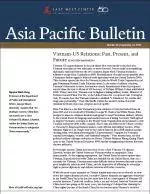Error message

Vietnam-US rapprochement in the past thirty-five years mostly took place after Vietnam overcame its own reluctance to move forward. Serious talks on normalizing diplomatic relations between the two countries began when Vietnam decided to withdraw troops from Cambodia in 1989. Normalization of trade became possible after Vietnamese leaders signed a bilateral trade agreement with the United States in 2000. This decision opened the door for Vietnam to join the World Trade Organization and gain Permanent Normal Trade Relations status. In the realm of military relations, Vietnam's reluctance to move forward was clearly demonstrated when it postponed several times the visit to Hanoi of US Secretary of Defense William Cohen until March 2000. Three years later, Vietnam sent its highest-ranking military leader, Minister of Defense General Pham Van Tra, to the United States for a reciprocal visit. During his visit, Tra made clear that Vietnam wanted to establish "a framework for a stable and long-term partnership." Once this hurdle within the sensitive realm of security relations had been overcome, progress moved rapidly. Nguyen Manh Hung traces the evolution of Vietnam-US relations and highlights potential challenges that may affect bilateral relations in the future. The views expressed in this publication are those of the author and do not necessarily reflect the policy or position of the East-West Center or any organization with which the author is affiliated. |
Vietnam-US rapprochement in the past thirty-five years mostly took place after Vietnam overcame its own reluctance to move forward. Serious talks on normalizing diplomatic relations between the two countries began when Vietnam decided to withdraw troops from Cambodia in 1989. Normalization of trade became possible after Vietnamese leaders signed a bilateral trade agreement with the United States in 2000. This decision opened the door for Vietnam to join the World Trade Organization and gain Permanent Normal Trade Relations status. In the realm of military relations, Vietnam's reluctance to move forward was clearly demonstrated when it postponed several times the visit to Hanoi of US Secretary of Defense William Cohen until March 2000. Three years later, Vietnam sent its highest-ranking military leader, Minister of Defense General Pham Van Tra, to the United States for a reciprocal visit. During his visit, Tra made clear that Vietnam wanted to establish "a framework for a stable and long-term partnership." Once this hurdle within the sensitive realm of security relations had been overcome, progress moved rapidly. Nguyen Manh Hung traces the evolution of Vietnam-US relations and highlights potential challenges that may affect bilateral relations in the future. The views expressed in this publication are those of the author and do not necessarily reflect the policy or position of the East-West Center or any organization with which the author is affiliated. |







